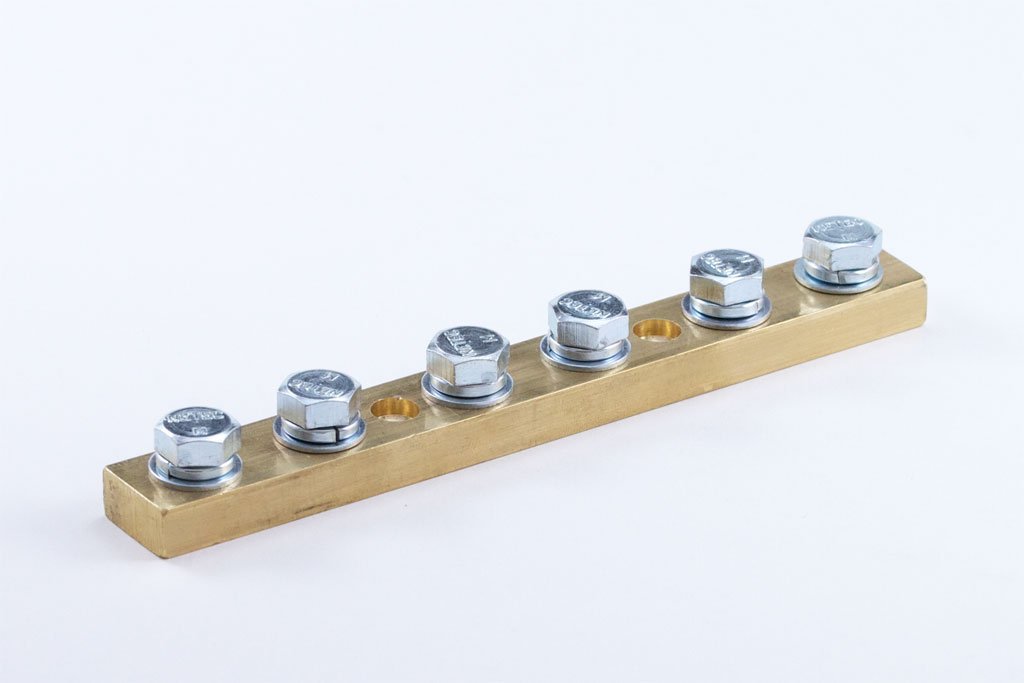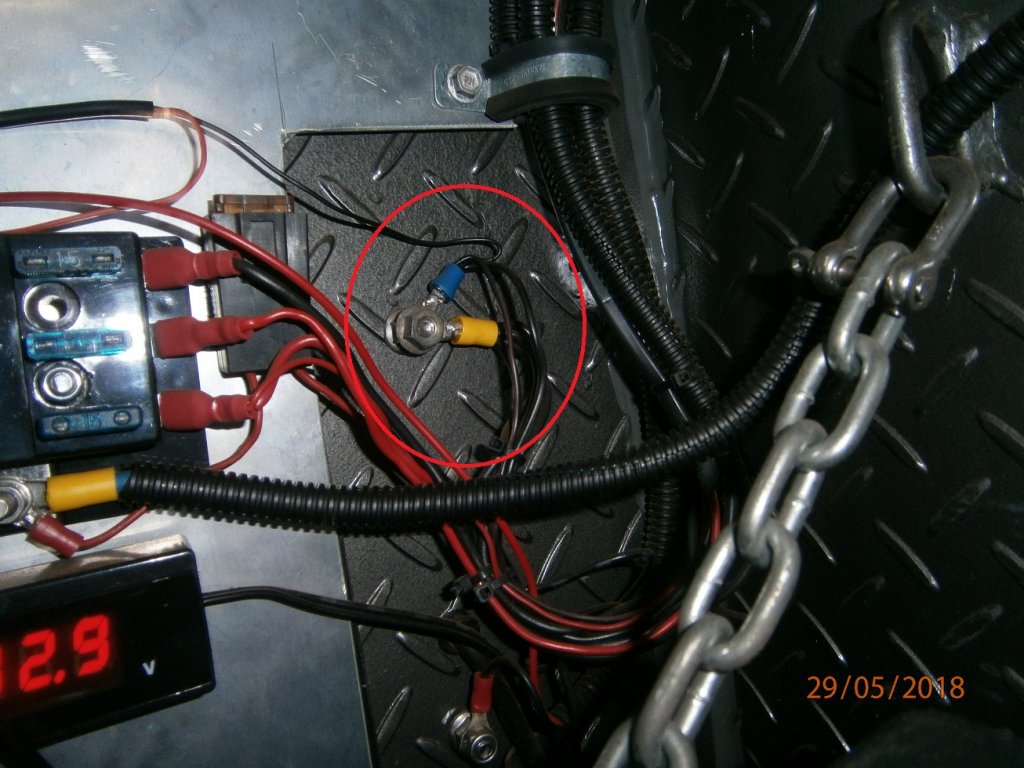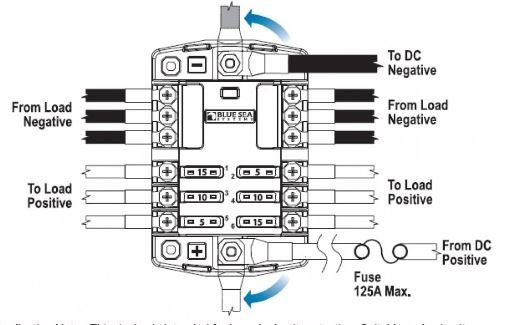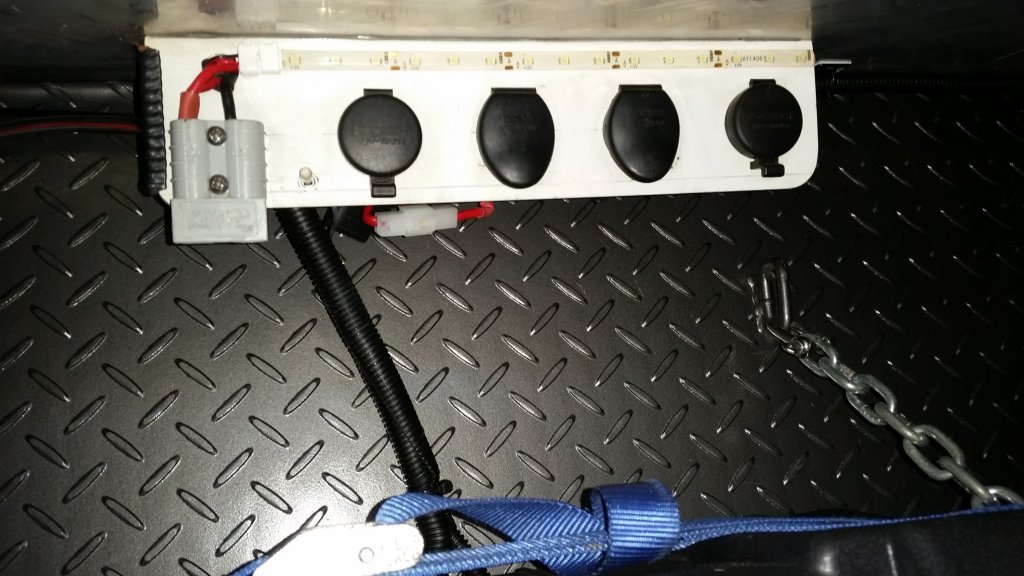using the grounding block will be a tidier job if each earth wire has the right terminal connection, easier to disconnect an appliance by undoing a screw
You are using an out of date browser. It may not display this or other websites correctly.
You should upgrade or use an alternative browser.
You should upgrade or use an alternative browser.
DEEP CYCLE BATTERIES and BUSH POWER
- Thread starter condor22
- Start date

Help Support Prospecting Australia:
This site may earn a commission from merchant affiliate
links, including eBay, Amazon, and others.
iamagoldenoldie2 said:using the grounding block will be a tidier job if each earth wire has the right terminal connection, easier to disconnect an appliance by undoing a screw
Yes the one pictured by Nucopia is good for light duty stuff like LEDs and usb power ports etc but the main downside is the closeness of terminals makes it hard to get any decent size wiring / terminals onto them. Earth bolt also gives you a chassis earth which even though going straight to battery neg is still a plus. Basically comes down to if your just wanting to add accessories like lights etc or drive things like pumps, fridges or other goodies with pumps that draw a bit of current. No argument here, just trying to offer poster some pros and cons on choices :Y:
This type of thing would cover all bases in that gives a chassis earth along with good size terminal access plus a lot more robust.

Not sure but maybe I need to clear things up a little..
The system I am planning is for a camper trailer that will run off 2 x 100amp deep cycle batteries charged by a 200wtt solar panel through a 30 amp charger controller.
I have the 12 pin fuse block, a 50 amp reset circuit breaker and a couple of isolator switches. As well as the USB ,cig sockets and a few on/off rocker switches for the lights water pump..
I have 4 low wattage LED strip lights for inside side the camper as well as two LED strip lights for under the gazeebo.
The 12 volt water pump in the camper is for a 90 ltr water tank and I want to add a couple of cig shockets and USB charging points in side the camper trailer.
I have a 1000wtt PSW inverter that I use with an isolator switch on its own separate circuit already mounted inside the front tool box.
I thought as I have very little knowledge or experience on electrical wiring , that the grounding block might be a better option for me to run the negative wires from lights pump cig/usb etc back to a single point. The other thing was the Fuse block only allows positive to positive connections..
I dont have a wiring diagram to use as a guide, which would probably help make it easier and give a clearer picture but from looking over many wiring diagrams on google it seems like it might be the way to go..
Looked on fleabay for the blocks but wow its confusing ... most come from the states China and are expensive
Cant seem to find any places locally that stock them ????
The system I am planning is for a camper trailer that will run off 2 x 100amp deep cycle batteries charged by a 200wtt solar panel through a 30 amp charger controller.
I have the 12 pin fuse block, a 50 amp reset circuit breaker and a couple of isolator switches. As well as the USB ,cig sockets and a few on/off rocker switches for the lights water pump..
I have 4 low wattage LED strip lights for inside side the camper as well as two LED strip lights for under the gazeebo.
The 12 volt water pump in the camper is for a 90 ltr water tank and I want to add a couple of cig shockets and USB charging points in side the camper trailer.
I have a 1000wtt PSW inverter that I use with an isolator switch on its own separate circuit already mounted inside the front tool box.
I thought as I have very little knowledge or experience on electrical wiring , that the grounding block might be a better option for me to run the negative wires from lights pump cig/usb etc back to a single point. The other thing was the Fuse block only allows positive to positive connections..
I dont have a wiring diagram to use as a guide, which would probably help make it easier and give a clearer picture but from looking over many wiring diagrams on google it seems like it might be the way to go..
Looked on fleabay for the blocks but wow its confusing ... most come from the states China and are expensive
Cant seem to find any places locally that stock them ????
Your all good ...................... nothing simpler or cheaper than a bolt with two nuts.  Becomes a common earth point and also takes earths to chassis. You could probably even leave it at that but then you run the risk of getting poor earth thru chassis back to battery. Wire from earth post to battery eliminates that. If you look at earth post in picture I have even connected multiple items thru one eye terminal to earth post. No need to connect each item separately as that's why it's termed "common earth" as its common to all. Simply bang a hole in and lock a bolt into it then use second nut to secure terminals ............... simple as and effective as job done :Y:
Becomes a common earth point and also takes earths to chassis. You could probably even leave it at that but then you run the risk of getting poor earth thru chassis back to battery. Wire from earth post to battery eliminates that. If you look at earth post in picture I have even connected multiple items thru one eye terminal to earth post. No need to connect each item separately as that's why it's termed "common earth" as its common to all. Simply bang a hole in and lock a bolt into it then use second nut to secure terminals ............... simple as and effective as job done :Y:
 .
.

Cheers Bogger ..
I recon i will get there eventually ..
I recon i will get there eventually ..
Any time it feels difficult mate, remind yourself of how many dollars your saving :Y: Plus your learning along the way .................. it's only the first one that's hard 
Just to add, your better in a way to connect and solder into one eye terminal rather than connect all individually to a bus bar, in the fact that all and any connection points are both a possible failure point / voltage loss point. The less points to fail the less chance of a failure :Y: Just protect all items thru a fuse and your good to go. On a camper it's probably only a fridge power point, water pump and winch that I wouldn't run thru a light duty fused connection block. As time consuming as it is, I prefer soldering joints to crimping and that's another benefit of doing it yourself, in that if it takes an extra hour .......... who cares
Just to add, your better in a way to connect and solder into one eye terminal rather than connect all individually to a bus bar, in the fact that all and any connection points are both a possible failure point / voltage loss point. The less points to fail the less chance of a failure :Y: Just protect all items thru a fuse and your good to go. On a camper it's probably only a fridge power point, water pump and winch that I wouldn't run thru a light duty fused connection block. As time consuming as it is, I prefer soldering joints to crimping and that's another benefit of doing it yourself, in that if it takes an extra hour .......... who cares
- Joined
- Jul 20, 2016
- Messages
- 2,274
- Reaction score
- 2,272
Bogger, that brass bus bar looks nice :Y: :Y: , what's it rated to and where from?
Cheers
Cheers
Look for a 240 v earth terminal at Middy's or similar.
Occasional_panner said:Bogger, that brass bus bar looks nice :Y: :Y: , what's it rated to and where from?
Cheers
Going by their blurb 165A cheap also and out of Vic :Y:
http://netec.com.au/plus/index.php?route=product/category&path=173_209_220
- Joined
- Jul 20, 2016
- Messages
- 2,274
- Reaction score
- 2,272
Thanks Bogger me likey :Y: :Y:
Oooooh I like this http://netec.com.au/plus/Neutral_Earth_Links/Stud_Only_Bars/250_Amp_Stud_Only/NST250-06A-F
Oooooh I like this http://netec.com.au/plus/Neutral_Earth_Links/Stud_Only_Bars/250_Amp_Stud_Only/NST250-06A-F
I have installed this type of unit in my van (from Jaycar - but not exactly as shown - the one from Jaycar is limited to 60A), but only for low Amp (<15A) circuits.(i.e.: rear camera [fused at 1A], 3* extra cig charging sockets [fused @ 15A each], 2 * USB charging sockets [fused at 5A each] etc). LEDs light to show if a fuse has blown (and a load is plugged in).
The highest draw is 10A for the 12V cig outlets for charging my PC, so used appropriately rated cables to those sockets (60A).
The one shown is from Blue Sea who also make great 12V gear.

The highest draw is 10A for the 12V cig outlets for charging my PC, so used appropriately rated cables to those sockets (60A).
The one shown is from Blue Sea who also make great 12V gear.

Occasional_panner said:Thanks Bogger me likey :Y: :Y:
Oooooh I like this http://netec.com.au/plus/Neutral_Earth_Links/Stud_Only_Bars/250_Amp_Stud_Only/NST250-06A-F
OP ya getting a bit flash now
Makes my home made power bank look real primitive

condor22
Mike
Am away prospecting with bugger all internet. So briefly, the fuse block I have is rated to 100 amps total, the individual loads I run vary from 1 amp to 10 amps.
The wire size of the individual load terminals needs to suit the applicable load and cable length.
However, the supply terminal wiring needs to suit the total and maximum load expected and therefore be heavier. Thus the fuse block should be close to the battery to minimise the supply cable voltage drop.
A negative rail, terminal block etc is also a good idea as it makes the connections to the battery less and tidier.
The wire size of the individual load terminals needs to suit the applicable load and cable length.
However, the supply terminal wiring needs to suit the total and maximum load expected and therefore be heavier. Thus the fuse block should be close to the battery to minimise the supply cable voltage drop.
A negative rail, terminal block etc is also a good idea as it makes the connections to the battery less and tidier.
Thanks condorcondor22 said:Am away prospecting with bugger all internet. So briefly, the fuse block I have is rated to 100 amps total, the individual loads I run vary from 1 amp to 10 amps.
The wire size of the individual load terminals needs to suit the applicable load and cable length.
However, the supply terminal wiring needs to suit the total and maximum load expected and therefore be heavier. Thus the fuse block should be close to the battery to minimise the supply cable voltage drop.
A negative rail, terminal block etc is also a good idea as it makes the connections to the battery less and tidier.
Suggestions noted, enjoy your time out bush mate.. :Y:
Nice to hear from you condor22. You have been missed.
Just curious , if u r out bush with say 3 x batteries on you which will possibly last for 4 x days, with no 240 volt power source near by, would a 2Kva generator be ok? Some people say that it is not appropiate because of voltage in geny go up and down. And how long would it take to charge battery?
And what generator? Honda gens put out a current (I think called a sine wave) that doesn't vary so can be used for laptops, etc.
A simple 500W inverter and a deep cycle battery charges all of my phones, detector batteries, etc for several days.
A simple 500W inverter and a deep cycle battery charges all of my phones, detector batteries, etc for several days.
- Joined
- Sep 4, 2014
- Messages
- 8,938
- Reaction score
- 6,788
Most generators have either a 4 Amp or 5 Amp and some with an 8 Amp charger built in, So I would buy one with an 8 Amp charger, Other than that you could grab your self a 100 watt foldable portable Solar Panel kit and they will put about 5 to 6 Amps per hour back into the batteries which with 3 batteries will be around 2 amps per hour per battery so you could get about 14 Amps per battery per day, under normal conditions a 100 watt panel "can" put out about 56 Amps per day if all goes according to plan,
Hope that helps.
RR.
Hope that helps.
RR.
Why carry all that weight, one battery will be sufficient.
If you have a fold up solar it comes wired parallel, wire it in series and connect to mppt solar regulator and charge your battery.
2KVA generator is ample, however me personally would plug in a 240V/12V battery charger to top up battery if clouds roll in. Only use the built in battery charger in an emergency.
If you have a fold up solar it comes wired parallel, wire it in series and connect to mppt solar regulator and charge your battery.
2KVA generator is ample, however me personally would plug in a 240V/12V battery charger to top up battery if clouds roll in. Only use the built in battery charger in an emergency.
Similar threads
- Replies
- 2
- Views
- 894


